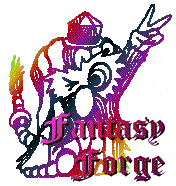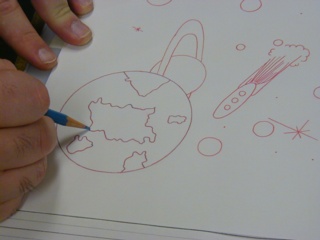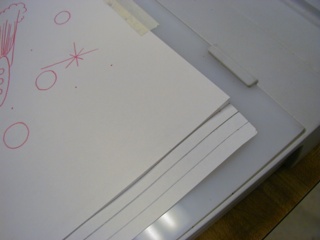 Return to the 3D menu |
 Return to the 3D menu |
When learning to create 3D separations, we will need to keep it simple. As you delve more into the world of 3D you can get more complicated. The initial learning curve is a bit steep, but once you've mastered the basics, it does not get a whole lot harder. Advanced techniques are just variations on the basics, and the complexity of your images will only be limited by your patience.
|
|
In addition to your 3D glasses you will want the following materials for this exercise:
|

First thing to do is to make a quick separation scale. This step is not entirely necessary, but while you are learning, it will make things easier. Place your paper in front of you so that the 11" length is horizontal. Next, take your ruler and measure four evenly spaced lines, one quarter inch apart, on the right side. These will later be used for image alignment purposes. The area left in which you can draw your initial picture is now 10" wide by 8.5" tall. Do not draw in the 1" end zone that you just ruled off.

Keep your drawing simple. Line drawings with no shading are fairly easy, and if you have never done this before, it is easy to get confused. Once you have your basic picture penciled in, ink it with your ball point pen. Make sure the lines are clean, concise and dark before you erase the pencil lines.
Look at your completed line drawing and decide at what levels you wish to have the objects in it appear. Planning the layers that are perceived in this picture I have listed them from the one in front to the ones in the back:
Now I am ready to set up my picture and separation.

Place your line drawing on top of the light box and cover it with a second sheet of paper. Align the top and bottom of both sheets exactly and align the cover sheet's right edge with the left most line of your separation scale (see picture above if you are confused). Use some tape to stick your pages down just like this so that they do not slide all over the place. If you do not have drafting tape handy, then use any sort of tape but make it less sticky by first taping it to a piece of cloth (like your pants), and then using it on your paper.

Turn on the light box and use your red pencil to trace the entire picture exactly. You will need to be very neat when you do this, tracing as exactly as possible. Do not worry about tracing the separation scale. It is not under your top sheet of paper, and it will not be copied onto the final picture at all.

When you have completed tracing the entire image in red, you can go ahead and turn off your light box for a while. You will now switch to the blue pencil for the rest of the project. Since non-photo blue pencils are a very light color, it may prove difficult to see what you are doing sometimes unless you look through a red filter. Feel free to occasionally use your 3D glasses to check your progress and see what blue lines still need to be drawn.
Use the blue pencil to retrace everything listed as being in layer 1. Draw right on top of the red lines as exactly as possible. These objects will eventually appear to be on the surface of the page.

When you have completed the retracing of layer 1, you will need to realign the two papers for layer 2. Move the top paper to the right so that the right hand edge of that sheet aligns with the second line of the separation scale. The top and bottom of the two pages must still be exactly aligned as well. Once again, tape the pages in place so that they do not slip.

Turn on your light box once again and trace all the lines of the objects in layer 2 exactly from your original black line image. These blue lines will mirror the red lines that they are paired with but about a quarter inch to the left. Be sure to trace the lines exactly. You draw the blue lines right over and through the red lines. Blue never stops for red since the blue and red images are actually separate pictures.
Once you have fully completed each layer of separation, you will realign the pages to the next line of the separation scale, and repeat the process. The final layer is where the pages are fully aligned at all four corners.

Completing this process gives you a basic anaglyph separation like the one above. As you draw it you will note that a couple of disturbing things may happen.
First, you should note that there are times when you should not complete a blue line because it would go behind a blue object on a higher level. Do not complete that line. Just stop it where it hits the object in front and go on to another line. Do not move where it is drawn. Overlapping objects will sometimes cut things off.
Second, you will see that sometimes objects in lower layers that overlapped in the red image are revealed more in the blue (as with the ringed planet in the example drawing). As the artist, it is up to you to fill in the missing parts on the blue drawing. Your blue lines get filled in until they are obstructed by other blue lined objects. Remember, blue never stops for red.

Your completed hand separation should end up looking something like this one. With a separation scale in quarter inches and a total shift of one inch, you will want to view it best from about 4-5 feet away. I have scaled it considerably smaller in this graphic, so you should not have to stand that far from your screen. If you wish to make pictures for closer viewing, you will want to make your separation scale thinner by comparison. You also do not need to use all 5 layers. Usually three is enough to get the 3D point across.